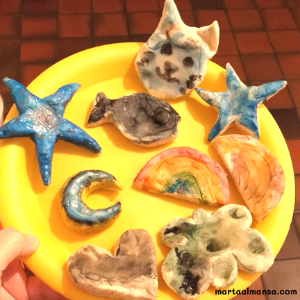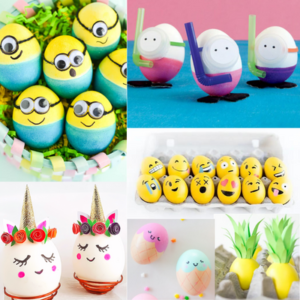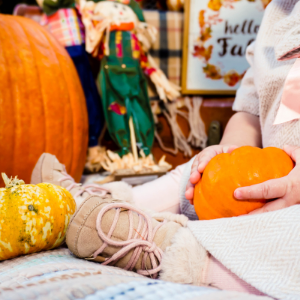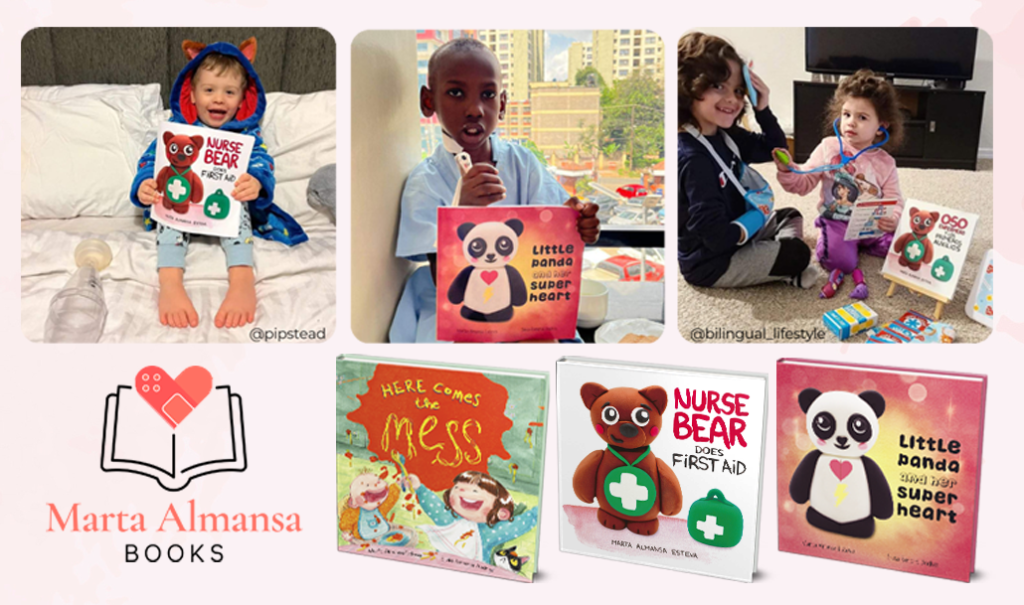One of the best ways to create a strong bond with your baby is to play, we all know that! But after hours and hours of play it’s common to run out of ideas. Don’t worry, I’ve got your back! These 18 crafts, activities and sensory play ideas for babies from 0 to 6 months old could save your day!

As an Amazon Associate I earn from qualifying purchases. This means I get a commission if you purchase the product through my link at no extra cost to you.
Activities and sensory play ideas for babies: newborn to 6 months old
Below you’ll find a list of 18 activities and sensory play ideas for your baby from birth until 6 months old. These can be introduced whenever you want and continue doing them regardless of the baby’s age, as long as you both enjoy them. The age ranges in brackets are merely a reference. During playtime, as well as during any other moment of the day, it’s really beneficial to talk to your baby. By explaining what you are doing you’re helping him/her learn about communication.
1. Things move (0-1 month)
When we move objects 20-25 centimeters from the baby’s face we’re helping him develop visual skills. Shiny objects will easily attract the baby’s attention and he may try to move his eyes or head to see where it’s moving. Bringing our hand or an object closer to and away from the baby’s eyes while lying on his back also helps to strengthen the eye muscles.
2. Baby gym (0-6 months)
There are baby gyms made of cloth (UK link / US link) as well as wooden baby gyms (UK link / US link). Some of them with toys that make noises or play music. We could help the baby to touch the objects by explaining what they are. If we shake the gym, all the hanging objects will move and catch the baby’s attention. After 2 or 3 months, babies usually try to pick up the objects (and will surely want to put them in their mouth). We could help them by closing their hand around the toy they’re interested in.
3. Music for babies and lullabies
Research has demonstrated that listening to classical music (such as Bach or Mozart) stimulates the parts of the brain associated with math and logic. Singing lullabies to your baby is fascinating for him and provides a feeling of safety. We could dance or sign while listening to classical music or lullabies. Don’t forget his favorite instrument is your voice!
4. Baby massage
Studies have shown that physical contact with the baby is as essential for him as vitamins to ensure his growth. The most recommended oil for baby massage is sunflower or almond oil. Coconut oil cools down quickly and can cool the baby’s body, and olive oil has a strong smell and perhaps the baby will be less focused on the massage and will want to chew your hands.
After preparing a warm room, with relaxing music and no screens, we’re ready to start. Helen Carr is an experienced Midwife and Baby Massage Instructor. Her step-by-step baby massage guide with photos is available on Bolton NHS Foundation Trust website. It’s important to establish eye contact with our baby, talk or sing in the meantime.
Massages to different areas have different benefits. For example, tummy massage helps relieve infant colic, increases bowel movements and prevents cramping. Head and jaw massage helps relieve teething pain.
5. Books are toys
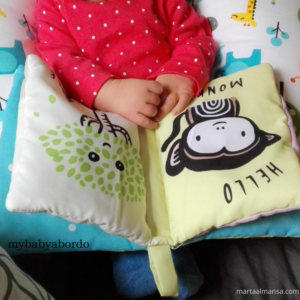
The perfect first baby book is soft, made of cloth, without many words (or none at all), but with pictures and bright colors (UK link / US link). We could turn the pages while talking about the drawings and colours, touch different textures… Books with black and white images (UK link / US link) captivate babies more easily because of the contrasts.
6. DIY Wooden ring
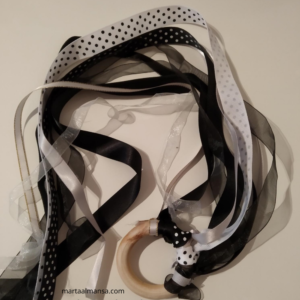
We should tie long strips of fabric or bows to a small wooden ring. The strips (about 40cm) can have different textures, thicknesses, colours and transparencies. With the baby lying down facing up, we show him the ring from above. He will see the different fabrics or bows move and that will fascinate him.
We could only use strips of black and white fabrics (semi-transparent, with white or black dots, matt or glossy…). It will be even more interesting for him as he’ll be able to focus more. These are the wooden rings (UK link / US link).
7. Action songs
Action songs are so much fun! As babies grow (especially from 3-4 months) they will recognize the rhythm of the songs and will know what is coming next. Babies love even more those with finger and hand movements. Some of them are: ‘head, shoulders, knees and toes’, ‘zoom, zoom, zoom we’re going to the moon’, ‘the Old Grand Duke of York’, ‘if you’re happy and you know it’, ‘the wheels on the bus’, ‘row, row, row the boat’, ‘wind the bobbin up’, ‘Hickory Dickory dock’, ‘round and round the garden’…
8. Learn about textures
It’s interesting to see the differences between textures and learning about them helps babies understand that opposite concepts exist (soft vs. hard, smooth vs. rough). You can gather several objects of different textures, shapes and sizes and let him feel them on his hands and feet. For example: a metal teaspoon, hard plastic tweezers, a soft silicone ball, a wool glove and a makeup brush (with full constant supervision). There are some very cute books with textures (UK link / US link).
9. Tummy time
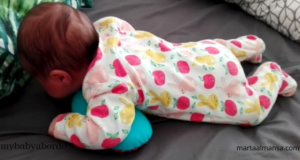
To lay on his tummy with his head raised takes practice, strength and time.There are specific toys and pillows to help babies improve this skill, or you can put them facing down on a blanket (although this will probably be more difficult for them at first). The baby is more likely to enjoy this position if we are at the same level and show him toys that he likes during tummy time.
Some experts recommend these exercises from 4 weeks of age. It is normal for the baby to be uncomfortable the first few times and last only a few seconds without complaining. That’s enough, it shouldn’t be forced. By repeating a little bit every day, sooner or later he’ll be doing tummy time happily for several minutes entertained while having a look around.
10. Laugh!
We could tickle the baby’s belly, under his arms or the soles of his feet slowly and then quickly. With our face close to his face, stick the tongue out. After some repetition, one day he will copy us and stick his tongue out! Blowing raspberries on the baby’s tummy is fun not only because of the tickling sensation but also due to the noise it makes.
11. Water play
Games with water help unconscious learning, on top of being very entertaining. Water fills things, splashes, pours, drips, some objects float in it and others sink. If the baby is not yet sitting on his own: someone gently holds him, and another person could help him bend his knees in the water to encourage kicking, or raise his arms by the shoulders and releasing them carefully so that he learns to splash. Later, when he knows how to sit independently: we could place floating animals in front of the baby, sink them and they will rise by themselves, fill and empty pots or plastic containers and encourage the baby to do the same.
12. Rattles and sound blocks (2-6 months)
Toys that make noises are a hit with babies. We could experiment with different rattles, shake them quickly or slowly, closer or farther from his ear to see the volume changing. We could put the rattle in his hand so that he tries to grasp it and help him shake it so he realises that a sound is created when he moves his hand. There are rattles with multiple sounds: bells, rice or lentils, plastic balls. These Rainbow sound blocks (UK link / US link) are amazing due to both the noises and the lovely colours.
13. Bubbles are fun (3-6 months)
Bubbles fascinate little ones, especially after three months. They want to touch them or catch them and they are surprised when they pop. We could blow bubbles in the air or have some bubble fun during bath time too.
14. Sensory bottles
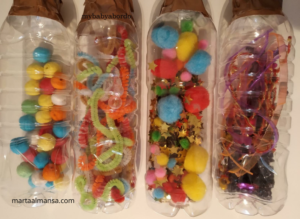
Sensory bottles are bring many hours of entertainment. The contents of the bottle move and change shape as well as emit sounds: could there be something more interesting for a baby?
You can make your own sensory bottles by putting whatever you want inside empty bottles and making sure they are tightly closed after to avoid accidental opening. We could fill them with colored pompoms, bells, fabric straps, shiny plastic stars, lentils, macaroni or oil with water, for instance.
15. Puppets
Babies love puppets. If we imitate the sounds animals make, tickle the baby with the puppet, sing songs while the puppets dance or tell stories in which they are the main characters, it’s so much fun!
16. Peek-a-boo! (from 3 months)
We could cover our faces with our hands and say “where is mum/dad?” and uncover them with a funny face and saying “peek-a-boo!”. Around eight or nine months, the baby could hide under a blanket or towel so that we both take turns playing peek-a-boo.
17. Ball games
Ball games combine physical skills and hand-eye coordination. We could start by using balloons filled with air (safe ones): put them on the baby’s legs and he’ll see when he kicks the balloon moves. Or we could play catching the balloon in the air. This Sensory Textures Multi Ball set (UK link / US link) is a must for babies from 0 to 6 months old. A large, soft, bouncy ball can also be used when they’re a little bit older.
18. Blocks
Wooden blocks (UK link / US link) stimulate our baby in many ways. Before he can stack them, our baby will take one in his hands and study it carefully turning it around to have a good look. Later he will be able to keep one in each hand and learn to hit them against each other to make a noise. Babies don’t usually try to stack blocks before 11 months.
To start playing with blocks, you can put cubes of different shapes, sizes and colors in front of the baby and describe them: ‘this yellow block is rectangular’, ‘this big one is green and round and it rolls on the floor’. You can build a tower with different pieces that the baby will surely throw to the ground very soon.

